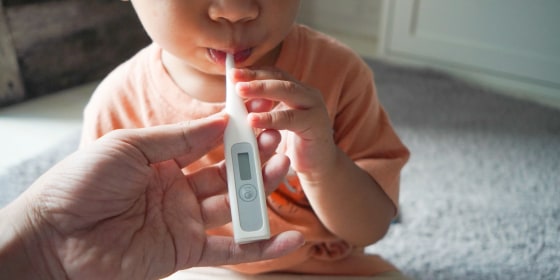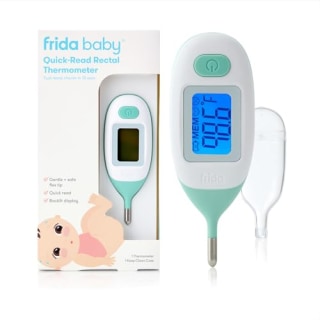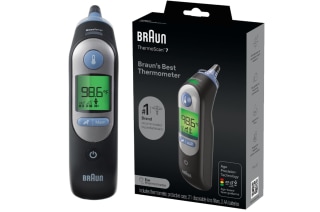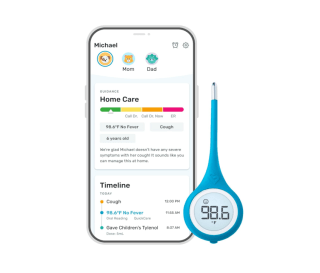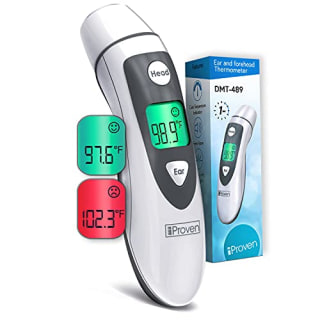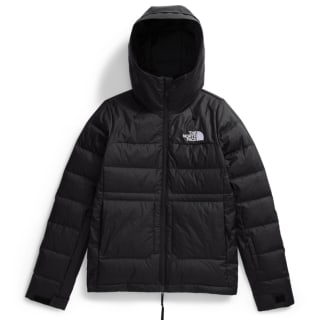If you or someone in your home is feeling sick, one of the most important things to do first is to check your temperature with a thermometer. Temperature is an important vital sign that health care providers use to determine the severity of your illness, says Dr. Cory Fisher, a family medicine provider with the Cleveland Clinic. Your temperature reading, and how long you have a temperature help determine potential causes for illness and treatment plans, says Fisher.
Thermometers come in different shapes, sizes and types, including oral, ear and forehead thermometers. We spoke to medical experts about the different types of thermometers, and which options you should consider for your household’s needs.
Which type of thermometer is the most accurate?
There are a few different types of thermometers on the market today. Our experts explain how each one works, and the pros and cons of the different types available.
Digital body thermometers
Digital body thermometers use heat sensors to determine body temperature. They can be used to take a temperature in the mouth, rectum or armpit. Each method of taking a temperature with a digital thermometer can impact accuracy.
Oral: Oral thermometers have a probe that’s placed under the tongue, and are the most accurate for adults and children four years and older, says Dr. Heather Viola, a primary care physician at Mount Sinai Doctors Ansonia. They often take longer to get a reading than other types of thermometers. If kids can’t keep the thermometer under their tongue for the full duration of the reading, Viola recommends using another option.
Rectal: Rectal thermometers have a probe that’s placed inside the rectum, and are recommended for infants and children under 3 years old, according to the American Academy of Pediatrics.
Armpit or axillary: Some digital thermometers can be placed under the armpit to measure body temperature. This method is not as accurate as oral or rectal readings, says Viola, so it’s best to use it as a quick first check, and follow up with an oral or rectal reading if the armpit temperature is above 99 degrees Fahrenheit.
Ear thermometers
Digital ear thermometers — formally called infrared tympanic thermometers — measure the temperature inside the ear canal using infrared technology, says Viola. They’re particularly convenient for older babies and children since they usually get a result in one to three seconds, which is often quicker than oral thermometers. But ear thermometers can be difficult to position, are usually the most costly option and can give you a cooler reading if the probe tip is cold, says Viola.
Forehead thermometers
Forehead, sometimes called temporal, thermometers use infrared technology to measure your temperature through the temporal artery on the forehead. Some forehead thermometers are placed directly on the forehead, while non-contact infrared thermometers use infrared technology to measure your surface temperature. Both types are generally less reliable and more costly than other thermometer options, says Viola, who recommends a digital oral, ear or rectal thermometer for accurate readings.
How we picked top-rated thermometers
There are dozens of thermometers available in stores and online, many from brands you may never have heard of. We narrowed down options and landed on our top picks by keeping the following in mind:
- Comfort: Because thermometers come in different shapes and can use different measuring methods, pick one that is most comfortable for you. If you have a hard time with things inside your ear, choose an oral thermometer over an ear one, for example.
- Ease of use: Viola recommends looking for options with start buttons that are easy to press, so you know the device is on and working when using it. Some models also beep when they are done taking a reading, which can be helpful.
Want more from NBC Select? Sign up for our newsletter, The Selection, and shop smarter.
Top-rated thermometers in 2026
With expert guidance in mind, we selected digital thermometers we think you should know about below. Each thermometer has a digital display, making it easy for you to read results, and many can take a reading in multiple ways.
Best overall
This thermometer is flexible and can be used as an oral, rectal or underarm thermometer, making it the best option for most people. It can take a temperature reading in eight seconds, according to the brand. The digital display changes color based on its readings: a green display means no fever, a yellow display means the temperature is slightly elevated and a red display means a fever is present. The thermometer automatically shuts off after use and its memory settings recall the last temperature taken if you need to compare them. It comes with batteries and a storage case.
Best budget
Best for infants
This thermometer is specifically designed for taking a baby’s temperature rectally. The probe is shorter than most thermometers and shaped to prevent over-insertion. It delivers a reading in 10 seconds and stores up to 10 previous readings, according to the brand.
Best ear
This ear thermometer is pricier but more advanced than other options. It helps you position it for the best possible reading — the screen flashes and emits a beep when it’s properly positioned in your ear. It takes a reading in seconds, and you can input the age of the person whose temperature you’re taking — the screen changes color based on the age and reading you get. The thermometer comes with lens covers, a case and batteries.
Best smart-connected
This thermometer can connect to a companion app, allowing you to keep track of temperatures over time (plus track medication and set reminders, if you want). Like our other options, it delivers a reading in less than 10 seconds, beeps when it is finished and shows temperatures on a clear, digital screen. It comes with a storage case.
Best forehead
This option can act as a forehead or ear thermometer — it has a built-in infrared sensor you can insert into the ear and comes with a cap you can place on top of the sensor to get a reading from the forehead. The thermometer can deliver a reading in one to three seconds and can recall 20 past temperatures, according to the brand. The thermometer also beeps and displays a red light on its screen when it detects a fever. It comes with a storage pouch and batteries.
Meet our experts
At NBC Select, we work with experts who have specialized knowledge and authority based on relevant training and/or experience. We also take steps to ensure all expert advice and recommendations are made independently and without undisclosed financial conflicts of interest.
- Dr. Cory Fisher is a family medicine provider with the Cleveland Clinic. He is also an adjunct clinical professor at Fairview Hospital’s Family Decine Residency program.
- Dr. Heather Viola is a primary care physician at Mount Sinai Doctors Ansonia. She is also an assistant professor in the Department of Medicine at the Division of General Internal Medicine at Mount Sinai.
Why trust NBC Select?
Zoe Malin is a reporter at NBC Select who has written about health since 2020, including topics like face masks, toothpaste and fluoride. For this story, she interviewed two medical providers about thermometers and illness.
Harry Rabinowitz is a reporter at NBC Select who covers technology including recent stories on blood pressure monitors, air purifiers and smart scales. He researched thermometers and selected different types that met our expert guidance.
Catch up on NBC Select’s in-depth coverage of tech and tools, wellness and more, and follow us on Facebook, Instagram, Twitter and TikTok to stay up to date.


